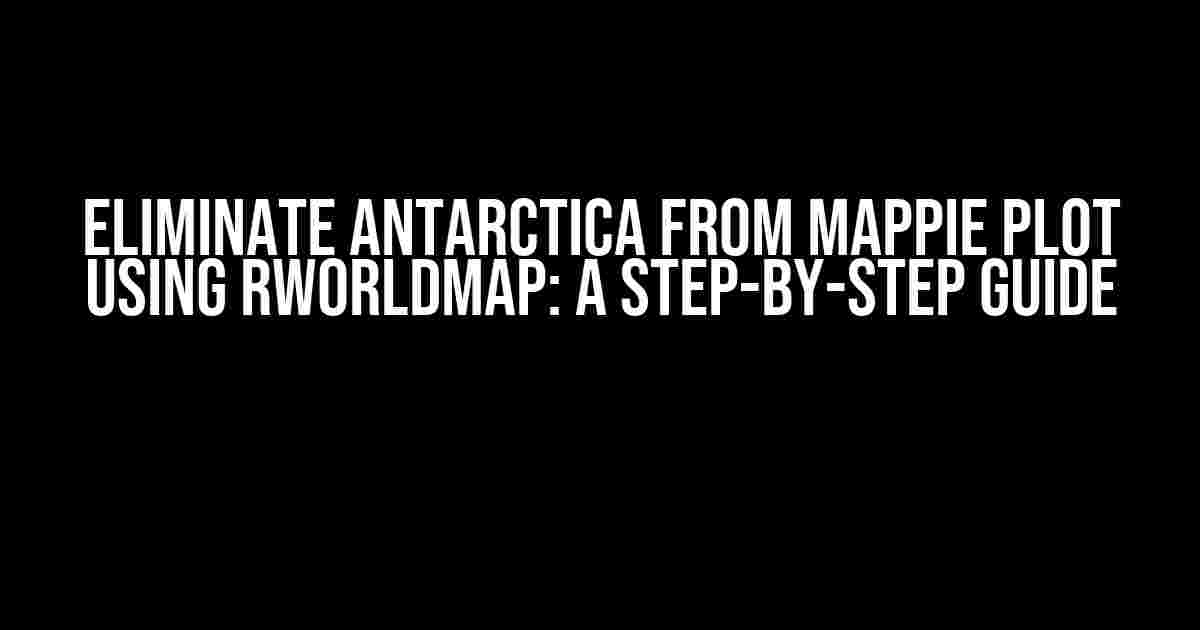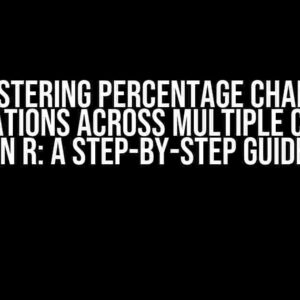Hey there, R enthusiasts! Are you tired of Antarctica stealing the spotlight in your MapPie plots? Do you want to focus on the more populous regions of the world without being distracted by the icy continent at the bottom of the globe? Look no further! In this article, we’ll show you how to eliminate Antarctica from your MapPie plots using the Rworldmap package.
Why Eliminate Antarctica?
Antarctica is an fascinating continent, but let’s face it – it’s not exactly teeming with people or economic activity. When creating MapPie plots, it’s often more useful to focus on regions with higher population densities or more significant economic contributions. By eliminating Antarctica, you can create more informative and engaging visualizations that highlight the areas that matter most.
Prerequisites
Before we dive into the tutorial, make sure you have the following installed:
- R programming language (version 3.6 or higher)
- Rworldmap package (install with
install.packages("rworldmap")) - A brief understanding of R basics (data frames, plotting, etc.)
Step 1: Load the Rworldmap Package and Data
library(rworldmap)
data("countryExData")
In this step, we load the Rworldmap package and the countryExData dataset, which contains information about each country’s population, GDP, and other variables.
Step 2: Create a Basic MapPie Plot
mapPie("POP_EST", main = "Population Estimates", xlim = c(-180, 180), ylim = c(-90, 90))
This code creates a basic MapPie plot showing the population estimates for each country. The `xlim` and `ylim` arguments are used to set the plot’s limits to ensure that Antarctica doesn’t dominate the visualization.
Step 3: Identify and Remove Antarctica
# Identify Antarctica's ISO code
ant_iso <- "ATA"
# Create a subset of countries excluding Antarctica
countries_no_ant <- countryExData[countryExData$ISO3 != ant_iso, ]
# Create a new MapPie plot without Antarctica
mapPie("POP_EST", data = countries_no_ant, main = "Population Estimates (No Antarctica)", xlim = c(-180, 180), ylim = c(-90, 90))
In this step, we identify Antarctica's ISO code ("ATA") and create a subset of countries that excludes it. We then use this subset to create a new MapPie plot that focuses on the more populous regions of the world.
Customizing Your Plot
Now that you've successfully eliminated Antarctica, it's time to customize your plot to better suit your needs. Here are a few tips:
-
Use the `col` argument to change the color scheme of your plot. For example, `col = "blue"` would create a blue-themed map.
-
Experiment with different `main` titles to convey the message of your plot.
-
Use the `xlim` and `ylim` arguments to zoom in on specific regions or adjust the plot's aspect ratio.
Common Issues and Solutions
If you encounter issues while creating your MapPie plot, refer to the following troubleshooting tips:
| Issue | Solution |
|---|---|
| Error: "countryExData" not found | Make sure you've loaded the Rworldmap package and data using library(rworldmap) and data("countryExData"). |
| Antarctica still appears in the plot | Double-check that you've correctly subset the data to exclude Antarctica (ISO code "ATA"). |
| Plot appears distorted or cluttered | Adjust the `xlim` and `ylim` arguments to zoom in on specific regions or improve the plot's aspect ratio. |
Conclusion
Eliminating Antarctica from your MapPie plots is a simple yet effective way to create more informative and engaging visualizations. By following the steps outlined in this article, you can focus on the regions that matter most and create stunning Rworldmap plots that showcase your data in the best possible light.
Happy plotting, and don't let Antarctica freeze your chances of creating amazing visualizations!
Frequently Asked Question
Got questions about eliminating Antarctica from your map pie plot using rworldmap? We've got answers!
Why would I want to eliminate Antarctica from my map pie plot?
You might want to eliminate Antarctica from your map pie plot if you're not interested in including it in your analysis or visualization. Perhaps you're focusing on a specific region or continent, and Antarctica is not relevant to your study. By eliminating it, you can simplify your plot and make it easier to interpret.
How do I eliminate Antarctica from my map pie plot using rworldmap?
You can eliminate Antarctica from your map pie plot by using the `joinCountryCoords` function in rworldmap and specifying the countries you want to include. For example, you can use the `country` argument to exclude Antarctica by setting it to `-990` (Antarctica's country code). You can also use the `region` argument to specify a specific region or continent to include.
What if I want to exclude other countries or regions from my map pie plot?
You can exclude other countries or regions from your map pie plot by using the same approach as eliminating Antarctica. Simply specify the country codes or region names you want to exclude using the `country` or `region` arguments in the `joinCountryCoords` function. You can also use logical operators to combine multiple criteria for exclusion.
Will eliminating Antarctica affect the accuracy of my map pie plot?
Eliminating Antarctica from your map pie plot should not affect the accuracy of your plot, as long as you're using a reliable source of country boundary data and correctly specifying the countries or regions you want to include. However, if you're using a dataset that includes Antarctica, make sure to handle the missing data correctly to avoid any inaccuracies.
Can I customize the appearance of my map pie plot after eliminating Antarctica?
Yes, you can customize the appearance of your map pie plot after eliminating Antarctica. rworldmap provides various options for customizing the plot, such as changing the color scheme, adding labels, or modifying the legend. You can use these options to create a visually appealing and informative plot that meets your needs.


